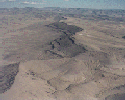 |
Earth Science Studies of Yucca
Mountain |
Scientists have made a great deal of progress in their
investigations of the geology of Yucca Mountain and its surrounding
region to determine if the mountain can isolate radioactive
materials be using natural and engineered (man-made) barriers.
Observation of the natural system and data collected since 1978
suggest that the natural system is robust, which is to say that the
geological characteristics of the site appear to be
complimentary--can work together--in their ability to isolate waste.
Further studies are being done in these areas:
- Geology: the science that deals with the history of the earth
as recorded in rock.
- Geohydrology: the science that deals with the quantity,
quality and movement of underground water.
- Tectonics: the study of faults, which are cracks in the
Earth's crust accompanied by movement of one side of the crack in
relation to the other.
- Seismology: the study of earthquakes, which occur when rock
moves along a fault.
- Volcanology: the study of volcanoes.
|
|
Layers of different rock conditions
at Yucca Mountain |
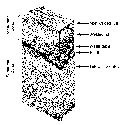
|
Yucca Mountain has thick layers of volcanic rock called "tuff."
If you could take a slice of the mountain, this is how it might
look. Scientists have studied themountain to see where faults are
and where the saturated zone (the rock underneath the water table)
is and have found that the rock quality is as good or better than
assumed when scientists first considered a repository at Yucca
Mountain.
|
|
Studying water movement through
rock |
 |
Geohydrology studies have been focusing on finding out how much
water there is in the rock, how it moves through the rock, and how
water could affect a repository. Geologic evidence is consistent
with models of the site that have been the basis of performance
calculation for more than 10 years. However, scientists still must
determine the long-term significance of potential fast pathways for
water movement. This is important because scientists believe that
groundwater is the most likely way radioactive materials could be
released from a repository.
|
|
Little rainfall at Yucca
Mountain |
 |
Yucca Mountain is in the southern part of the Great Basin, where
there is very little rainfall, most of which quickly runs off the
surface or evaporates. Approximately 15 centimeters (six inches) of
rain falls on Yucca Mountain in a year. Scientists think that only
an extremely small fraction of that rain could soak into the ground
and actually reach the underground area where the potential
repository would be located. But they are conducting studies to
determine the exact nature of the movement of water through the
rock. Models and data have indicated that water infiltration could
be diverted laterally away from the repository level, potentially
acting as a buffer against increased rainwater infiltration in the
event of future climatic changes.
|
|
The water table under Yucca Mountain is extremely
deep |
 |
This makes it possible to put a repository about 300 meters
(1,000 feet) underground and still have it be about 240 meters (800
feet) above the water table. Geologists call the rocks and soil
above the water table the unsaturated zone. In the unsaturated zone
there is relatively little water in the rock and the water there may
move very slowly. These factors significantly limit the change of
water reaching the corroding waste containers and carrying
radioactive material away from a repository.
|
|
Earthquakes and faults of particular
significance |
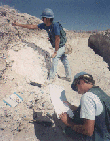 |
Project scientists have been studying faults and monitoring
earthquakes in the region surrounding Yucca Mountain for more than
10 years. Experience with earthquakes throughout the world has shown
that, generall, underground structures can withstand ground motion
generated by earthquakes. Tests involving nuclear explosions
underground at the Nevada Test Site have shown that underground
structures can withstand ground motion greater than that anticipated
from earthquakes.
|
|
Trenches dug to study
faults |
 |
As part of the studies, there are major trenching programs at
Yucca Mountain to study movement of faults during the past two
million years. Geologic study of the deposits found exposed in these
trenches and minerals found in fault zones will provide evidence of
how frequently and how much faults have moved in the past.
Geologists will use dozens of trenches to investigate past
movement of faults. The information will be used as part of the
seismic hazard analysis of Yucca Mountain.
|
|
Scientists are carefully studying
volcanic activity near Yucca
Mountain |
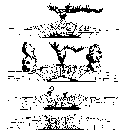 |
Yucca Mountain itself was formed millions of years ago by a
series of explosive volcanic eruptions from a special type of
composite volcano called a "caldera." Calderas form when large
volumes of magma erupt rapidly. This removes the underground support
for the volcano, and surface collapses and forms a circular
depression, or caldera. Calderas can range in size from the few
miles to tens of miles across.
The caldera complex, which was the source of Yucca Mountain's
welded tuffs, is about 20 miles across and centered about 17 miles
north of the mountain.
|
|
Seven inactive volcanoes in Yucca
Mountain area |
 |
The massive volcano that formed Yucca Mountain is long extinct,
but scientists are studying seven small and long inactive volcanoes
in the Yucca Mountain area. They want to determine if one might
erupt in the next 10,000 years and if an eruption might affect an
underground nuclear repository. By studying layers of soil and rock
to learn about past volcanic activities, scientists have been able
to make predictions about the future. The probability of a future
volcanic eruption directly intersecting a repository at Yucca
Mountain is estimated to be about one in 70,000,000 per year, as
confirmed by an independent panel of experts. This is in line with
earlier estimates by Project scientists.
|
|
Scientists estimate eruption
unlikely in next 10,000 years |
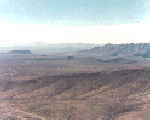 |
The seven inactive volcanoes in the Yucca Mountain area are
cinder, or scoria, cones. Of the three main types of volcanoes,
cinder cones generally have the simplest and weakest eruptions.
Scientists estimate that it is unlikely that any of the seven cinder
cones will erupt in the next 10,000 years, and extremely unlikely
that volcanic activity could directly disrupt the proposed
repository location.
|
|
Studies will take more than a
decade |
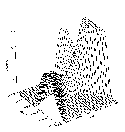 |
Scientists have spent more than a decade at Yucca Mountain
studying whether volcanoes or other geologic events might affect a
repository. They have used samples from drilled holes, trenches, and
geophysical methods in laboratory studies to get the data they need.
These studies of volcanology, seismology, geohydrology and
geology have given scientists the information they need to make
decisions about the suitability of Yucca Mountain as a spent nuclear
fuel and high-level radioactive waste repository.
|


![]()

